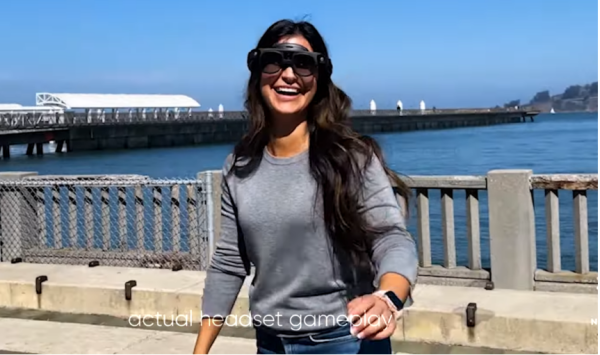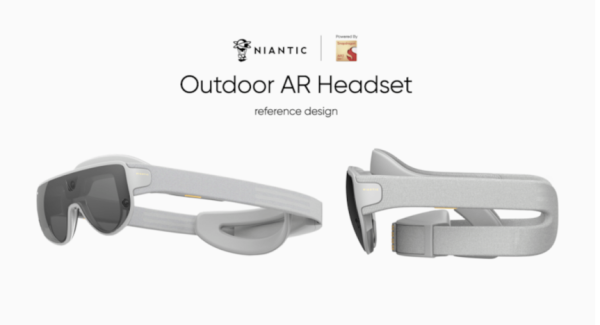Niantic Announces an Augmented Reality Headset in Partnership with Qualcomm
Niantic has announced a new outdoor Augmented Reality headset in collaboration with Qualcomm. Niantic and Qualcomm are partnering in the development of a reference design for augmented reality glasses. That reference design is showcased in the demo below of the two companies’ vision of heads-up outdoor play.

The headset was unveiled to coincide with Qualcomm’s reveal of its new Snapdragon AR2 augmented reality chip. During the presentation, Qualcomm and Niantic revealed the reference design for an augmented reality headset that has been designed for outdoor use.
This “Outdoor AR headset” will be used as the basis for future augmented reality headsets that will be built by other manufacturers. Qualcomm’s OEM partners include Pico, OPPO, Nreal, Lenovo, LG, Xiaomi, Tencent, Sharp, and Vuzix. The headset has an elastic headband that folds up and allows the battery to move to the back of the head to provide good weight balance.

The Niantic and Qualcomm collaboration will offer benefits for the AR software, too. From 2023, Niantic’s “Lightship VPS” (Visual Positioning System) will be compatible with Qualcomm’s Snapdragon Spaces developer platform. Apps that are built using Qualcomm’s AR development platform will, thus, be easily expandable with VPS functionality.
Niantic’s Visual Positioning System was launched for AR studios at the end of May this year. It works by precisely and persistently placing gamers on a 3D map that is shared collaboratively. On this 3D map, players can see the same computer graphics in the world including signposts, interactive artworks, or monsters among others. The VPS map is so accurate that it works within a centimeter of precision.
Through the Niantic-Qualcomm partnership, the two companies intend to accelerate the development of augmented reality headsets which can be used outdoors just like conventional eyewear.
The reference model on the display features transparent displays similar to those in Nreal Light or Microsoft’s HoloLens 2. This kind of design is not yet ready for everyday use because the technology still faces critical problems like a narrow field of view and space problems. The color passthrough in virtual reality headsets like the Meta Quest Pro or Lynx R1 is far more advanced in rendering impressive mixed-reality experiences.
In the video passthrough technology, a video image of the physical environment that is streamed into the headset is enhanced with computer graphics. The inside-out tracking in video passthrough can, however, fail if the lighting conditions are either too dark or too bright; and if the headset shuts down, you will pretty much be staring into the darkness, which is, obviously, not suited for outdoor usage. The current VR headsets are still too bulky and conspicuous for outdoor usage. The ideal is to have this kind of technology inside glasses that look fairly normal and can be worn outdoors.
AR Games with a Centimeter-Precision in the Real World
A trailer was released that demonstrates the Niantic-Qualcomm reference AR headset in use. In the trailer, you can see test subjects walking together in a city center. The participants are walking along virtual path markings on real footpaths. They can even open information boards at designated landmarks and see game characters that run up the walls or across the real asphalt.
There is an action game where the test subjects control meter-high combat robots sprinting across meadows or firing fire missiles at one another on rooftops. The video shows players using a motion controller that has a touchpad for the thumb. The Snapdragon augmented reality chip also provides support for hand tracking although this is not shown in the video.
Niantic’s Visual Positioning System (VPS) mapping of real-world locations is a key basis for the augmented reality experience. The VPS enables a community of gamers and developers to collaborate on Niantic’s digital globe. Apart from the spatial scans, photographs also add to the 3D reconstruction.
The project started in 2020 by enabling the scanning of the real-world environment in Pokemon GO. More than 30,000 locations across the globe already have VPS support. These are mainly located in major cities.
Android and iOS devices still play a critical role in the augmented reality content experience. In the future, depending on the evolution of XR hardware, these will eventually be replaced by VR and AR glasses.
Niantic says it is planning to take LightshipVPS to “as many hardware devices as possible” to power location-based augmented reality experiences.
The Niantic-Qualcomm headset is an early reference design and the construction may still undergo further changes.
Niantic has a number of software ideas for headsets. Recently, the company showcased a trailer showing augmented reality apps that are playable on smartphones. Among these are sprouting flower meadows in Tower Superbloom AR or the monster-fighting MMO ARealm.
Niantic announced the Lightship VPS for Web in September. Through the VPS, content that is linked to real-world locations is availed in the mobile browser.
https://virtualrealitytimes.com/2022/11/19/niantic-announces-an-augmented-reality-headset-in-partnership-with-qualcomm/https://virtualrealitytimes.com/wp-content/uploads/2022/12/Niantic-Headset-Reference-Design-600x355.pnghttps://virtualrealitytimes.com/wp-content/uploads/2022/12/Niantic-Headset-Reference-Design-150x90.pngAugmented RealityTechnologyNiantic has announced a new outdoor Augmented Reality headset in collaboration with Qualcomm. Niantic and Qualcomm are partnering in the development of a reference design for augmented reality glasses. That reference design is showcased in the demo below of the two companies’ vision of heads-up outdoor play. The headset was...Rob GrantRob Grant[email protected]AuthorVirtual Reality Times - Metaverse & VR
